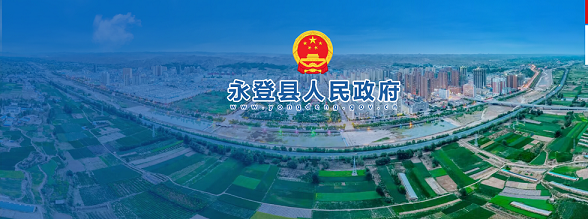Yongdeng County is located in central Gansu Province and northwestern Lanzhou City. It administers 3 townships, 13 towns, 11 communities, and 200 administrative villages, with a total population of 427,800, including 293,200 rural residents. It is home to 18 ethnic groups such as Han, Hui, Manchu, Tibetan, Mongolian, Tu, and Dongxiang, with ethnic minorities accounting for 4.5% of the total population. The county has successively won national and provincial honors, including Top 10 Counties in Gansu's County Competitiveness, Advanced Collective in Gansu's Poverty Alleviation, and the top of China's "Top 100 Counties with High Poverty Prevention Efficiency".

As early as the Neolithic Age, ancient residents lived and multiplied in Yongdeng. It is an important birthplace of the Majiayao Culture and Banpo Culture, and is known as the "Hometown of Painted Pottery". Since 121 BC (the second year of Yuanshou in the Western Han Dynasty), General Huo Qubing began to build the Lingju Frontier Pass, making Yongdeng's history span over 2,100 years.
Yongdeng is a vital hub on the ancient Silk Road and the Eurasian Land Bridge, and the eastern gateway to the Hexi Corridor. The county seat is 110 kilometers away from downtown Lanzhou, lying within the 1-hour urban economic circle. Lanzhou Zhongchuan International Airport is located within its territory. Lanzhou-Xinjiang Railway, Intercity Railway, National Highway 312, and G30 Expressway run through the entire county, while provincial highways and county-township roads crisscross. A convenient highway transportation network has taken shape, with national and provincial highways as the backbone and county-township roads as branches, connecting urban and rural areas and radiating to surrounding regions.
Yongdeng features diverse landforms, including basins, river valleys, hills, mountains, and grasslands, with overlapping mountains and crisscrossing rivers. Its terrain presents a "three plains flanked by two rivers" pattern: Babaochuan, Zhuanglangchuan, Qinwangchuan Plains, and Datonghe, Zhuanglanghe Rivers. The land slopes from northwest to southeast, with an altitude ranging from 1,590 meters to 3,650 meters.
The county has over 1.39 million mu of cultivated land, 908,000 mu of natural forests, and 5.482 million mu of grasslands. The main rivers in the territory are Zhuanglanghe River (a first-class tributary of the Yellow River) and Datonghe River (a second-class tributary of the Yellow River). The Yindarenqin Water Diversion Project has an annual water diversion capacity of 443 million cubic meters. Twenty-five mineral resources have been proven, including limestone, quartzite, marble, coal, and loess for cement admixtures, which are characterized by rich reserves, high grade, and easy mining. Relying on abundant mineral resources and location advantages, a large number of large and medium-sized backbone enterprises such as Qilianshan Cement, Lianhai Aluminum, and Tengda West Iron have been built successively. An industrial pattern dominated by mining, metallurgy, chemical industry, building materials, and hydropower development has basically taken shape, earning Yongdeng the reputation of "Metallurgical Valley" and "Hometown of Building Materials".
Yongdeng boasts extremely rich tourism resources. It is home to the Shuping Danxia Landform, which is the largest contiguous, most magnificent, and closest to a provincial capital in China. The Lutusi Yamen, an official complex known as the "Little Forbidden City of the Northwest", is the largest, oldest, and best-preserved of its kind in the country. Other attractions include Tulugou National Forest Park (a 4A-level scenic spot and one of China's Top 10 Model Forest Parks), the Yindarenqin Water Diversion Project (hailed as "Dujiangyan on the Longshang Plateau and the Milky Way on Earth"), and more than 10 unique natural and cultural landscapes such as Yaoshui Gou Hot Spring. There are also over 30 historical relics, including Mancheng Han Dynasty Tombs, Han and Ming Dynasty Great Wall sites, and Song Dynasty cliff carvings. Kushui Gaogaoqiao (Kushui Tall Stilts) and Taiping Drum have been listed as national intangible cultural heritage, while 7 items such as Kushui Xia'er Diao (Kushui Two-Tone Ballad), Tiexinzi (Iron Core Performance), and rose cultivation techniques are listed as provincial and municipal intangible cultural heritage.
Ten advantageous featured industries in Yongdeng are developing vigorously, including Kushui Rose, Plateau Summer Vegetables, Red Globe Grapes, Cold-Water Trout, and Qishan Mutton Sheep. In particular, Kushui Rose is a rare plateau selenium-rich rose variety in the world. Its planting scale and fresh flower output account for over 40% of the national total. In 1984, Kushui Rose was designated as the city flower of Lanzhou, and Yongdeng is renowned as the "Hometown of Chinese Roses". Agricultural and animal husbandry production bases such as the Hundred-Mile Rose Plain, Ten-Mile Grape Ditch, Ten-Thousand-Mu Chinese Medicinal Materials Valley, Plateau Summer Vegetables Green Corridor, and Qishan Alkaline Spring Mutton Sheep Natural Pasture have been fully formed, with products sold well across the country. Among them, Kushui Rose has successfully completed the registration of agricultural product geographical indication, and the "Gansu Yongdeng Kushui Rose Farming System" has been recognized as an Important Agricultural Cultural Heritage of China by the Ministry of Agriculture and Rural Affairs.
- Regional GDP: 12.598 billion yuan, an increase of 6.6% over the previous year.
- Primary industry added value: 1.642 billion yuan, an increase of 8.9%.
- Secondary industry added value: 3.588 billion yuan, an increase of 4%.
- Tertiary industry added value: 7.368 billion yuan, an increase of 7.2%.
- The ratio of the three industries: 13.03:28.48:58.48.
- Fixed asset investment: 5.718 billion yuan, an increase of 13% over the previous year.
- Added value of industrial enterprises above designated size: 2.34 billion yuan, an increase of 3.1% over the previous year.
- Total retail sales of consumer goods: 3.309 billion yuan, an increase of 7.2% over the previous year.
- General public budget revenue: 543 million yuan, an increase of 16.1% over the previous year.
- Per capita disposable income of urban and rural residents: 28,980 yuan and 13,950 yuan respectively, increasing by 7.6% and 10.7% over the previous year.

